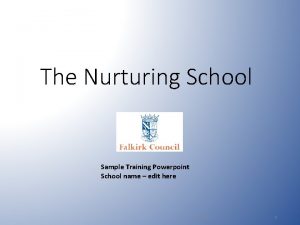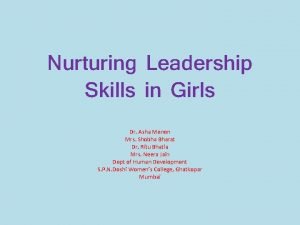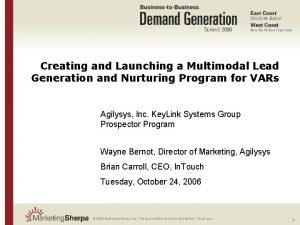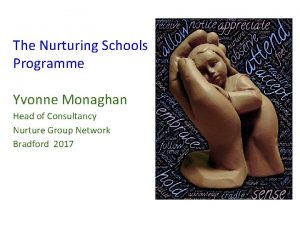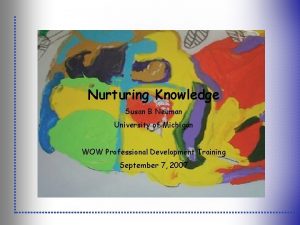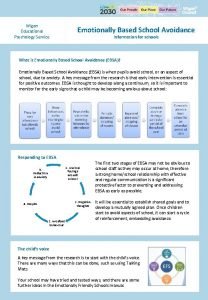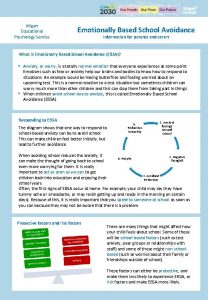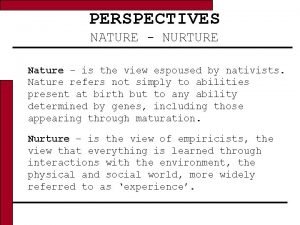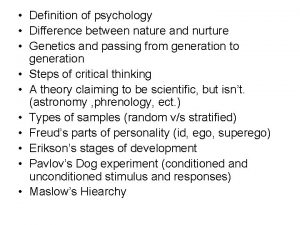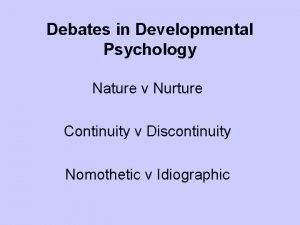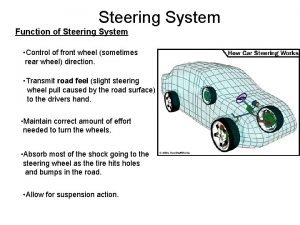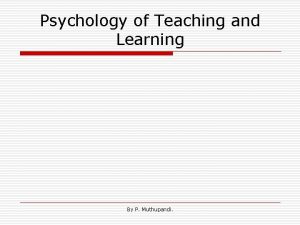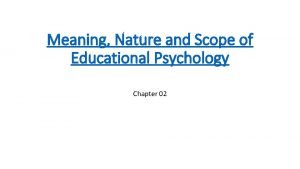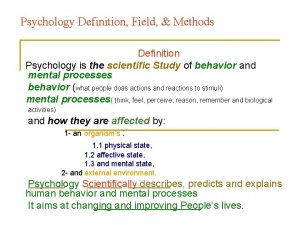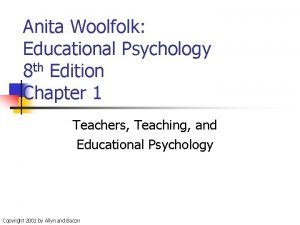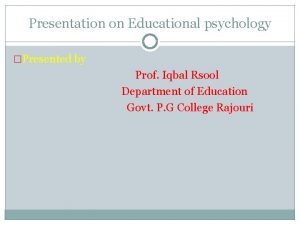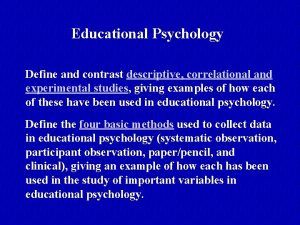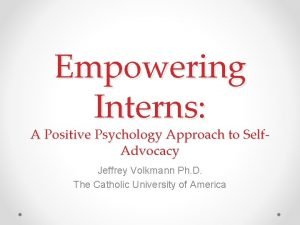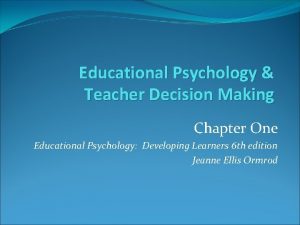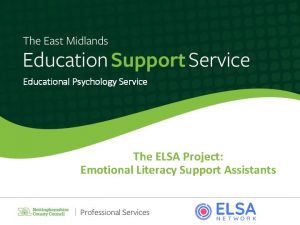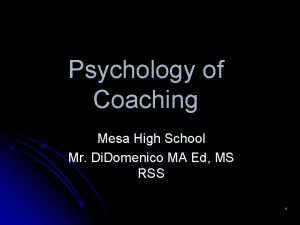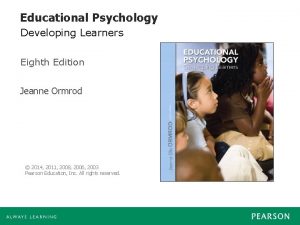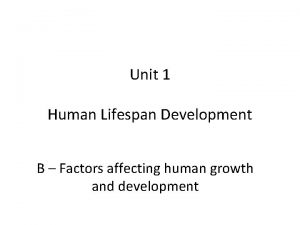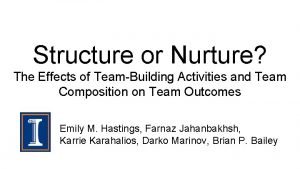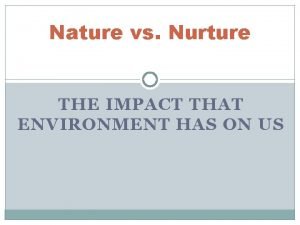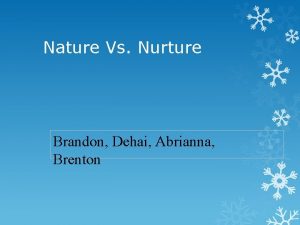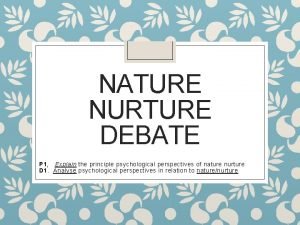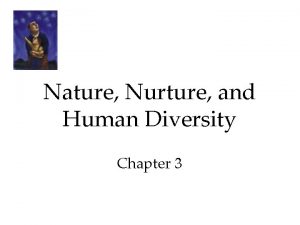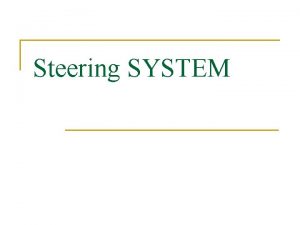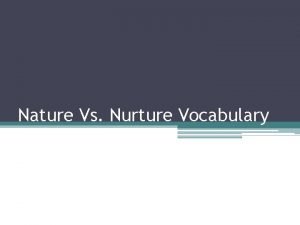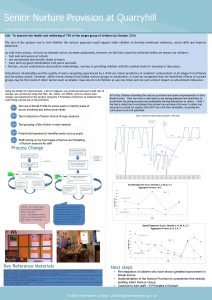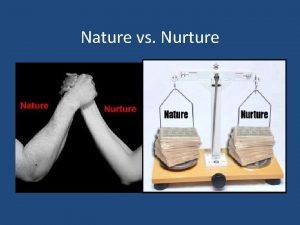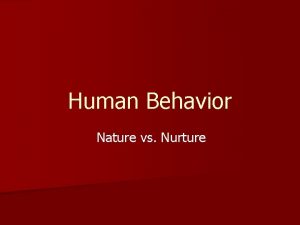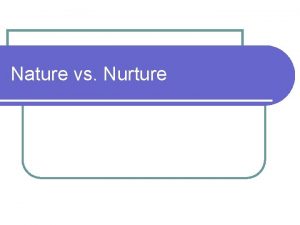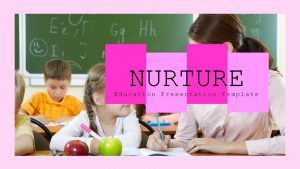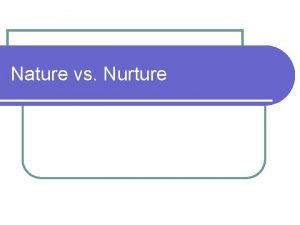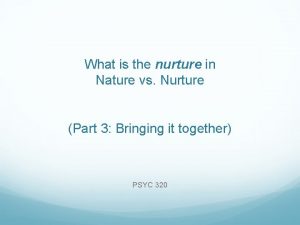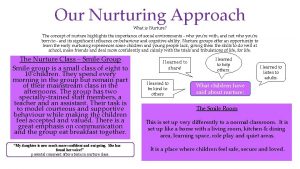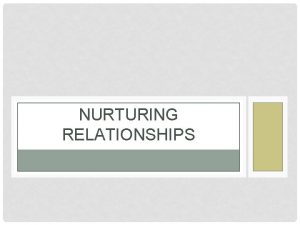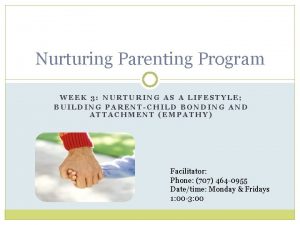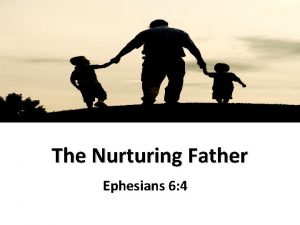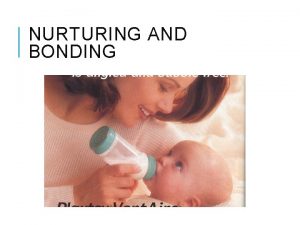The Nurturing School Educational Psychology Service Nurture Steering










































- Slides: 42

The Nurturing School Educational Psychology Service Nurture Steering Group Nick Balchin Principal Educational Psychologist Rhoda Marshall, Educational Psychologist 01 -Dec-20 1

Course overview Content Attachment Who will attend Wave 2 Project Team 2 Assessment of Need for Nurture Boxall Profile 3 Nurturing Principles Wave 2 Project Team Wave 1 participants who missed Reconnect in November/December Wave 2 Project Team 4 Nurturing in Practice. Approaches for whole school: Nurture Classes, Groups, Spaces and Nooks, Nurture practices in mainstream classes Wave 2 Project Team 5. Reconnector Session - TBC October 2016 Wave 2 Project Team 1 01 -Dec-20 Falkirk Council Educational Psychology Service 2

Overview • Reflection on learning • Attachment • Assessment • Nurture Principles • Nurturing communication • Attunement in the classroom • Emotional containment • Transitions • The Nurturing School approach 01 -Dec-20 • Nurture Methods • • • Nurture Classes, Nurture Groups Nurture Spaces Nurture Nooks, Nurture practices in mainstream classes • Planning the project of improvement • Progress to share in October Falkirk Council Educational Psychology Service 3

Learning Intentions • At the end of the session participants should be able to understand define the key areas of supporting positive attachments as part of a Nurturing School • Discuss Nurturing Whole School approaches and understand how these could be taken forward in your context 01 -Dec-20 Falkirk Council Educational Psychology Service 4

Reflections: Session 3 – you told us Indicators Secure Attachment Insecure Attachment What Helps? Themes & Structure & Routine examples • Pupil talk time • Expectations • Rules Communication • Body language • Positive Lang • Greeting Environment • Areas • Tidy/organised • Belonging Pupil engagement Child centred • Specific e. g. Visual Trusting Curious Imaginative play Responsive Boundaries High arousal state Over-stimulated Extreme reactions Lack Empathy Sensory Crave attention Relationships • Restorative • Mutual respect Remove barriers to learning • Emotional learning Additional • Welcome, Play, things to Snack, Learn think Managing micro about transitions Care on communication with parents Five to thrive – Language Play, Talk, Relax, Cuddle and Respond. Indicator may have a different cause Falkirk Council Educational Psychology Service State of arousal 01 -Dec-20 Safe base Barriers to learning Dyslexia, ASD, attention and concentration difficulties 5

The Six Nurturing Principles • Children’s learning is understood developmentally • The classroom offers a safe base • The importance of nurture for the development of self-esteem • The importance of transition in children’s lives • Language as a vital means of communication • All behaviour is a communication • In what ways have these principles impacted on your practice? 01 -Dec-20 Falkirk Council Educational Psychology Service 6

Activity 1 – 2 project teams at a table. Project teams share findings across the 4 tasks from last session Session Three: Learning tasks Group (project team) 1. Reflection on key themes from session three 2. Complete a school audit of how pupils are supported through transitions. Identify three strengths and three areas of development Practitioner (individual) 1. Observe and note 6 verbal interactions. Reframe interactions into nurturing statements. Provide reflection to support why you feel they are examples of nurturing communication 2. Consider the same two pupils from session one. Reflect on nurture principle one and three. Note what do you say and do to ensure that these nurture principles are evident in practice 01 -Dec-20 Falkirk Council Educational Psychology Service 7

Communication and Universal approaches • Attunement • Language • Non-verbal • Emotional containment • Transitions 01 -Dec-20 Falkirk Council Educational Psychology Service 8

Attunement In The School Is… • Tuning in to the child’s emotions, initiatives and communication • Responding positively in body language, eye contact and verbal interaction • Engaging in turn-taking, hearing the child’s view, recognising who is feeling what and responding to this: emotional attunement—”the ability to hear, see, sense, interpret, and respond to the client's verbal and nonverbal cues in a way that communicated to the client that he/she was genuinely seen, felt, and understood. ” Daniel Sigel 01 -Dec-20 Falkirk Council Educational Psychology Service 9

Language is understood as a vital means of communication across the school context Be explicit in communication through: • Wondering aloud “I’m wondering if you’re feeling anxious about having another teacher and that’s why you’re refusing to sit down” • Naming thought processes “I’m thinking it’s not a good idea to do that just now because it will mean that we won’t get to gym on time” • Provide verbal commentaries “Let’s go for a walk. That feels good. Now we’ve used up some energy we can do 10 minutes more of maths. ” • Checking out “You look like you’re worried about that. Have I got that right? ” Falkirk Council Educational Psychology Service 01 -Dec-20 10

Language is understood as a vital means of communication across the school context Children Need To Know That They Are… • Safe “Isn’t it good you’re safe here in school? ” • Wanted “We really want you to be here” • Listened to & their feelings are respected “I hear what you are saying and I understand that you feel angry” • Valued & worthwhile “You are a very important member of this class” Children may not seem appreciative of this, they may contradict what you say and act as if they don’t care…but these are vital messages for the child to hear on a repeated basis and key to future progress Falkirk Council Educational Psychology Service 01 -Dec-20 11

Non verbal Communication • The manner in which you deliver your verbal messages. • The inflection of your voice determines how a message is perceived by nuances in tone and volume • Only 10 -15% of our message are perceived by the words used.


Emotional containment Support others in interpreting their feelings for them • Label the emotions they are showing • Give the message that all feelings are ok to feel • Show understanding of why they may be feeling that way • Explore how other people may feel and how they show their feelings • Help child to regulate emotions through scripting such as self regulation scripting • Try to offer emotional containment Falkirk Council Educational Psychology Service 01 -Dec-20 14

Feelings: Common Difficulties • Transference – feelings or expectations from previous experiences are transferred to the current situation • Translate to the here and now ie social stories • Projection - feelings projected onto the adult • Don’t take personally • Be aware of what ‘hooks’ the child may try to use • Acknowledge feelings • Remain calm in asserting they are there to help Falkirk Council Educational Psychology Service 01 -Dec-20 15

Supporting Feelings And Managing Behaviour • At all times communicate 2 key messages of: • Respecting their feelings • Offering boundaries for their behaviour • Behaviour can be seen as a means of communicating • When the child is calm: • Name the unacceptable behaviour • Work on a restorative task to resolve the harm caused • Offer hope to the child that you will help them practise to keep their fear under control • Indicate that the relationship is still intact Falkirk Council Educational Psychology Service 01 -Dec-20 16

Creating A Soothing Environment • Hyper vigilance can be seen in the: • Classroom always turning around • Dining hall too distracted to eat • Playground overwhelmed • Approaches: • Be aware of sensory aspects (hearing, vision, touch, proxemics, smell, taste, quiet times, low lights, etc) • Consider seating to minimise distractions • Use social stories ie what to do in a noisy environment 01 -Dec-20 Falkirk Council Educational Psychology Service 17

Predictability & Transitions • Children need more information rather than less • Let them know loudly and clearly what is happening • Prepare for changes to routine ie visual timetables, social stories, practising new routines, timers, count down. • Reassurance of ‘keeping in mind’ ie memory cards, concrete reminders • Reassurance in transition • Familiar object, photos, touch, eye contact, physical proximity. • Help develop concept of permanency • Sensory reminders, touch, verbal reassurance, eye contact, physical presence Falkirk Council Educational Psychology Service 01 -Dec-20 18

Activity 2 • 10 minutes • Role play with a partner (preferably not in your project team): • One of you is a child, the other and adult. The child is communicating in a way that suggests they may need emotional containment. • Adult try to provide emotional containment • 5 minutes reflection • What worked? • What aspects about transition or the environment may have helped? 01 -Dec-20 Falkirk Council Educational Psychology Service 19

Nurture and Learning – whole school approach The Nurture approach at whole school can consist of several methods: • Relationships with parents • Nurture practices in mainstream classes, such as the social development curriculum (Universal) • CARES – a communication framework to support Nurturing Practice • Targeted Assessment and intervention using the Nurture Approach tools in mainstream • Nurture Nooks (nurturing spaces created in mainstream classes or Nurseries. • Nurture Spaces (nurture room timetabled for different groups or classes) • Nurture Groups (small group once or twice per week) • Nurture Classes (small group every morning) It is more than this… 01 -Dec-20 Falkirk Council Educational Psychology Service 20

A Nurturing school • Ensuring all staff understand the implications of attachment theory and stress on children • Increasing the knowledge of support staff who are working with children with trauma • Allowing time in the day for relationship building • Developing alternative non behaviourist ways of relating to troubled pupils and providing them alternative strategies • Ensuring staff feel cared for so their care-giving capacities are maximised 01 -Dec-20 Falkirk Council Educational Psychology Service 21

Whole School Examples • Playground • Food • Pupil participation • Parents • Transition times • Celebrations 01 -Dec-20 • Feeling book / feelings tree/ worry box – any member of school can record their feelings • Whole school quiet assembly • Enter and leave candlelit hall in silence or listening to music • 15 minutes in quiet reflection. • Head teacher leads on a theme (spiritual/emotional) • Feeling book read (4 minutes thinking about the people in book) • Class circle time – after quiet assembly • Celebration assembly – share successes in and out of school • Nurture room - chair tables, opportunities for sharing food • Nurture lunch/Star diners project • Quiet room • Darkened / soft lighting / bubble tube • Aroma stone scents the air • Snugly cushions and relaxing seats Falkirk Council Educational Psychology Service 22

Ethos and culture School improvement project • Self-evaluation and improvement • attachment informed education, • assessment and intervention • Nurture Schools Resource Pack 01 -Dec-20 Falkirk Council Educational Psychology Service 23

Targeted Approaches 01 -Dec-20 Falkirk Council Educational Psychology Service 24

What Does A Nurturing School Promoting Positive Attachments Look Like? • Nooks • Good relationships with parents • Supportive peer relationships • Key adults • Containment and touch • Support for self-regulation 01 -Dec-20 Falkirk Council Educational Psychology Service 25

Typical Nurture Room Shelves/ Dresser for Crockery, Cutlery etc. Sink Dining Table and Chairs Kitchen table for preparation Cooker Fridge freezer Work table Large dolls house Mat Sofa Toys, cars, garage etc. Books Mirror Door Computer Area Pupils writing area Soft / quiet area: soft toys, large bean bags and floor cushions Books

A Place To Eat And Share 01 -Dec-20 Falkirk Council Educational Psychology Service 27

A Comfy Space… 01 -Dec-20 Falkirk Council Educational Psychology Service 28

Our needs met in a comforting way 01 -Dec-20 Falkirk Council Educational Psychology Service 29

A Happy Face 01 -Dec-20 Falkirk Council Educational Psychology Service 30

Using the room How depends on assessed needs of children and time available. • Nurture Space • classes or groups use it either as-and-when or timetabled • Nurture Group or Resilience Group • Small group, extracted for sessions twice a week, for specified period • Nurture Class • Recommended part time, up to 5 mornings a week. Think about age range, and group dynamics as well as assessment. • NOT a go to resource in emergencies • The fidelity of the intervention is important! Consistency and stability. • If assessment really not working then seek advice or try a different assessment. 01 -Dec-20 Falkirk Council Educational Psychology Service 31

Project of Improvement Needs analysis to real needs Quantitative data collected data from needs analysis Qualitative data re-defined problem statement

Needs-analysis reporting Half of the children thought. . . The majority of staff were of the opinion. . . 60% of parents interviewed thought. . . The main concerns raised were. . . What are the headlines from your needs analysis? What is your front page headline?

Effective Interventions/ projects 1. Real school needs 2. Multi-level intervention Pupil skills Environment Staff skills/group level Whole school – ethos and practice 3. Evidence based 4. Evaluation built into design 5. Sustainable and embedded

Project dwindle Enthusiasm Dwindle factor Time

Sustainable Projects Preventing the dwindle factor Review and plan Event to relaunch project communicate results, celebrate success Problem solve with staff

Project Planning See To lead or Not to Lead training or managing school Projects • Identified school improvement area – RACI and Task Briefs • Coaching • Task planning • Gantt chart 01 -Dec-20 Falkirk Council Educational Psychology Service 37

Accreditation – Level 1, Plan, Do, Review Your School Project on Nurture 1. Develop an action plan (task brief) and identify priorities for improvement that • fit your context • address your children and school’s needs. • Can be done with the resources/staff you have 2. Explore the needs of your school (views and data). • How would visitors identify elements of a nurturing school in your school? (ask them) 3. Provide information raising awareness session to all staff using the training materials provided. 4. Gather needs analysis data, views of staff and analyse what it means for your school 5. Refine your project plan and implement • For example mainstream focus, or targeted intervention focus. 6. Arrange a consultation with your link EP. Send copy of the plan to Educational Psychology Service : IAS@Falkirk. gov. uk 7. Prepare for Reconnector (October 2016) – share practice 8. Evaluate your plan/task brief in line with wider school improvement plan. Send results of your implementation/evaluation to Educational Psychology Service (June 2017). 01 -Dec-20 Falkirk Council Educational Psychology Service 38

Learning Intentions • At the end of the session participants should be able to understand define the key areas of supporting positive attachments as part of a Nurturing School • Discuss Nurturing Whole School approaches and understand how these could be taken forward in your context 01 -Dec-20 Falkirk Council Educational Psychology Service 39

Questions? 01 -Dec-20 Falkirk Council Educational Psychology Service 40

Your role!

Suggested reading (and references) • Theraplay (Booth & Jernberg 2010) • Settling to learn (Bomber & Hughes, 2013) • Inside I’m Hurting: Practical Strategies for Supporting Children with Attachment Difficulties in Schools. Louise M. Bomber (2007). Worth Publishers • A Short Introduction to Attachment and Attachment Disorder. Colby Pearce (2009). JK Publishers • Attachment and Teaching Styles. Philip Riley • Attachment-focused Parenting: Effective Strategies to Care for Children (2009). Dan Hughes. Norton 01 -Dec-20 Falkirk Council Educational Psychology Service 42
 Nurturing school
Nurturing school Nurturing leadership qualities
Nurturing leadership qualities Lead nurturing for charter schools
Lead nurturing for charter schools Lead nurturing reseller
Lead nurturing reseller Yvonne monaghan
Yvonne monaghan Supplementary nurturing
Supplementary nurturing Nurturing knowledge
Nurturing knowledge Wigan educational psychology service
Wigan educational psychology service Wigan educational psychology service
Wigan educational psychology service What is nurture in psychology
What is nurture in psychology Nature and nurture
Nature and nurture Nature
Nature Distinguish between nature and nurture
Distinguish between nature and nurture Continuity stages psychology
Continuity stages psychology Difference between nature and nurture
Difference between nature and nurture Function of a steering system
Function of a steering system Relationship between education and psychology
Relationship between education and psychology Scope and importance of educational psychology
Scope and importance of educational psychology Psychology definition
Psychology definition Educational psychology theory and practice
Educational psychology theory and practice Anita woolfolk educational psychology
Anita woolfolk educational psychology Educational psychology conclusion
Educational psychology conclusion Define educational psychology
Define educational psychology Positive psychology internships
Positive psychology internships Discuss briefly the nature of educational psychology
Discuss briefly the nature of educational psychology Educational psychology
Educational psychology Educational psychology
Educational psychology Scope of educational psychology
Scope of educational psychology Educational sport psychology specialists
Educational sport psychology specialists Ormrod educational psychology
Ormrod educational psychology Trumbull county educational service center
Trumbull county educational service center Trumbull county educational service center
Trumbull county educational service center Gesell nature vs nurture
Gesell nature vs nurture Nurture examples in real life
Nurture examples in real life Nature vs nurture activities
Nature vs nurture activities Nature vs nurture experiments
Nature vs nurture experiments Dani lierow
Dani lierow Nature vs nurture examples
Nature vs nurture examples Nature vs nurture examples
Nature vs nurture examples Nature versus nurture debate
Nature versus nurture debate Powerpoint
Powerpoint Nature nurture and human diversity
Nature nurture and human diversity Alir locke
Alir locke
